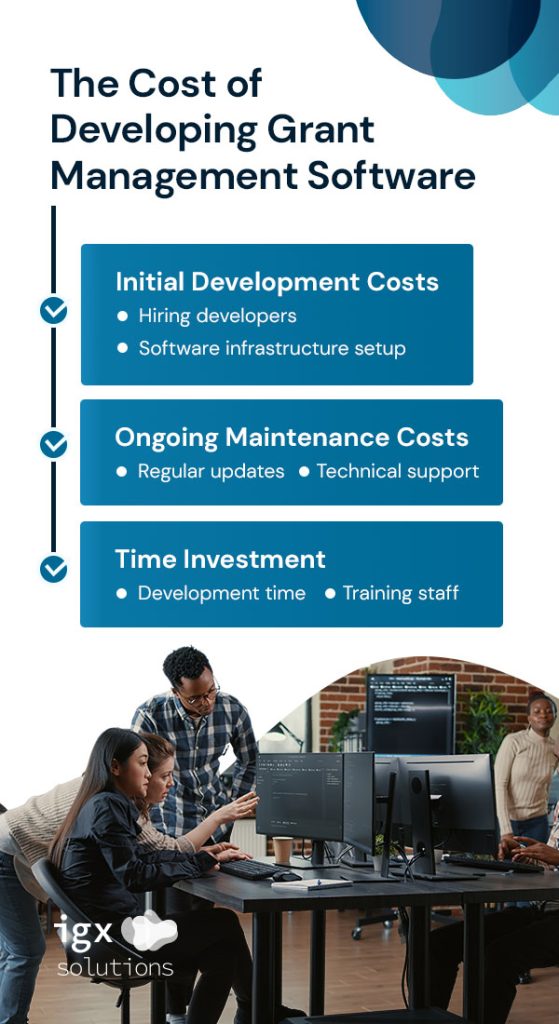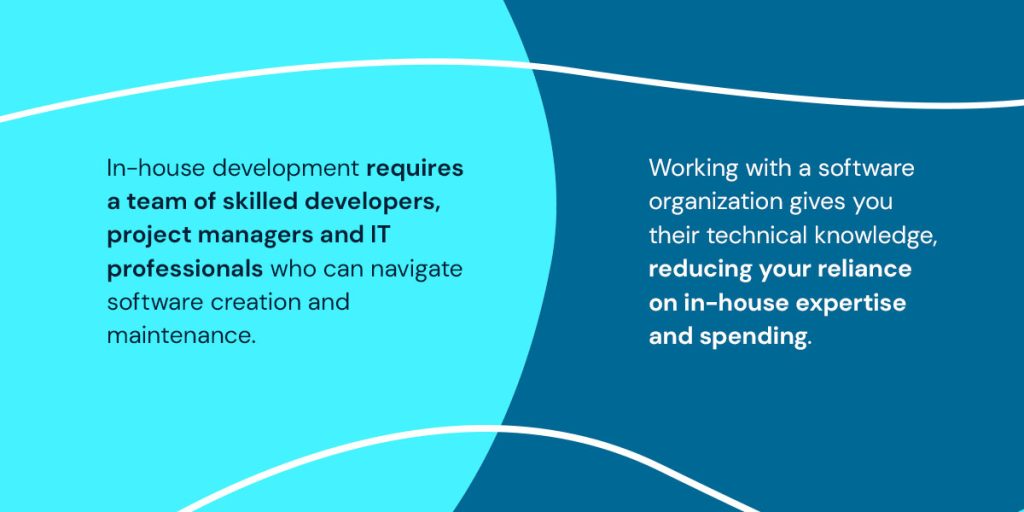
Grant management is a complex process that can make or break your operation. If you’re looking to streamline your grant management, specialized software is an excellent way to make the process easier. With grant management software, you can securely handle all your grant submissions, deadlines and approvals, allowing you to get the funding you need.
Getting the right grant management software is essential — picking the right setup lets you seamlessly integrate the software with your existing systems and helps you stay on top of grant management. Organizations will typically choose to create their grant management software in-house, or they’ll turn to a professional software company for their software needs. If you’re considering developing your management software from scratch, you’ll want to consider what it costs to have grant management software.
Let’s take a look at the different costs and challenges of in-house and pre-made grant management software to help you find the best fit for your organization’s needs.
If you want to build and run your own grant management software, you’ll need to consider all of the initial and long-term costs. Building grant management software in-house means investing in the right people and tools. Everything, from the initial planning to the continuous use of your software, needs careful planning.
Developing any software means considering the initial startup costs and labor. You’ll need to plan out what you want your software to do and how you will achieve those results — this helps ensure you have a clear direction in mind. Here are the two main initial development points you’ll need to keep in mind:
While the initial investment in labor and tools may seem significant, they lay the bedrock for a tailored, in-house solution that meets your grant management needs.
Running your software in-house means continually ensuring the software remains operational and updated. Here are two of the most important maintenance costs you need to be prepared to deal with:
Running your own management software also means investing lots of time into the whole process. You’ll need to invest significant time and resources into development and staff, which might delay your grant management.
If you want to get into grant management software, collaborating with a software organization can be an excellent solution, helping reduce costs and timelines. Still, you’ll need to consider the costs that come with using grant management software from another company.

While you have no development costs when you get software from an organization, there are still some initial costs to think about:
You may have to make regular payments to your software provider so you can continue to use it. These costs are often lower than what you would pay to run the software yourself, but you should keep them in mind when budgeting for grant management software.
While you don’t have to wait for your software to be developed from scratch, there’s still some deployment time with getting grant management software.

Finding the right grant management software for your business depends on your needs and operation. Evaluating the most important factors gives you a better idea of what you want. Here are the main factors to consider when choosing a grant management software.
Your organization’s budget is an essential factor when choosing between in-house development or a software organization.
Building grant management software internally means dealing with significant upfront costs — hiring, infrastructure setup and ongoing maintenance — that can set you back. In contrast, partnering with a software organization means getting a more predictable and manageable financial model, with licensing fees and subscription costs spread out over time.
You should weigh your available financial resources against your desired grant management system to find the best option for your team.

In-house development requires a team of skilled developers, project managers and IT professionals who can navigate software creation and maintenance. Look at your existing technical expertise — insufficient capabilities might lead to challenges in effectively developing and managing an in-house solution. Working with a software organization gives you their technical knowledge, reducing your reliance on in-house expertise and spending.
Your organization’s unique grant management needs are essential to consider when choosing your software option.
In-house development lets you tailor your software whenever you need it, letting you meet your changing needs. If you operate in a niche sector, being able to shape your software as needed might outweigh the costs and time investment of in-house development.
However, software organizations provide configurable solutions that work with a broad range of needs. If you want convenience and practicality, this may be the option for you.
In-house development involves detailed planning, hiring and development timelines, which will make your software process take longer. Partnering with a software organization means getting a quicker deployment time thanks to their pre-built solutions and streamlined implementation process. Your organization’s timelines and capacity to integrate swiftly need careful evaluation when picking a development approach.
As you weigh your grant development options, you should understand the risks that come with in-house development. While developing your own grant management software can be rewarding, there are some challenges you’ll face.
While in-house development offers you increased customization, it also means handling all of the expenses and challenges of software development. Working with a software organization eliminates all of these issues, letting you use the grant management software you need without having to deal with the extra budget, staff and technical issues of software development.

In-house grant software development takes valuable time and resources away from your organization. Using vendor grant management software allows you to enjoy all the benefits of grant management software without the stress of managing everything yourself.
IntelliGrants® IGX software delivers an experience tailored to the unique demands of grant administration. Keep your grant management processes fluid and seamless with tools carefully crafted for various organizations. Our commitment to versatility and efficiency is perfected in IntelliGrants IGX, offering configurable tools and features that seamlessly align with your workflow.
From intuitive navigation to status tracking throughout grant creation, application and review, our software empowers your team at every step. With a feature-rich interface and an off-the-shelf solution status, you just need to configure IGX Solutions software to your specifications. Choose IntelliGrants IGX for a streamlined grant management experience that elevates your organization’s efficiency and impact.
Are you ready to get started? Book a demo today.